FORMS
OF REPRESENTATION IN HINDU-JAVANESE TEMPLE SCULPTURE
August
1998, Funded by William Graf Travel Grant, Hunter College
Kristine Marx
My
interest in Hindu architectural sculpture lies in its treatment of
representation. Although not unique to Hindu art, the mixing of types
of visual signs, from iconographic to narrative, is prevalent. Originating
from a vastly different cultural context, some recent Western art
exhibits a comparable merging of signifiers in constructing space
and content. It is this cross-cultural use of a similar aesthetic
approach, although for greatly dissimilar conceptual ends, that I
find compelling. The following is a brief description of my experience
of Indonesian Hindu monuments.
| I
visited temples located in central Java near the modern city of
Yogyakarta. These sites included the Larajonggrang temple complex
at Prambanan, the temples on Dieng Plateau, and the Gedung Songo
temples in the foothills of the mountain Gunung Ungaran (fig.
2). The structures at Dieng date from the 8th century AD; they
are Java's earliest, having been erected before the influx of
Buddhism. Although the Buddhists drove Hindu culture eastward,
Hindus returned to central Java in the 9th century and co-existed
with the newer religion. It was in this period that the Prambanan
shrines were built. Of the temples I saw, those at Prambanan were
the most impressive, with relatively elaborate reliefs. The body
of this essay focuses on this particular group. |
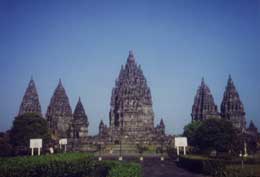
Figure 2 (Click to see larger version) |
The
temple complex at Prambanan consists of an inner courtyard with three
main shrines: the Shiva, which is the largest, the Vishnu, and the
Brahma. Directly opposing these structures lie smaller shrines housing
each god's respective vehicles: Nandi, or bull, for Shiva, Garuda,
or mythical bird, for Vishnu, and Brahma's goose called Hamsa (fig.
5). Ten still smaller shrines surround the perimeter of the courtyard.
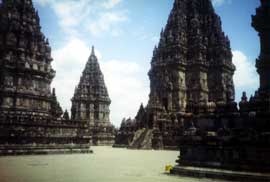
Figure 5 (Click to see larger image.)
Upon
approach, the scale of the shrines and their distance is difficult
to judge. The structures seem to recede from the observer, even when
in close proximity, so they always appear beyond reach, otherworldly.
Symmetry typically plays a strong organizational role in Hindu temple
architecture, as it does here in the plan of the buildings and in
the decorative and narrative reliefs. Because of its symmetrical plan,
I had the experience that each side of the temple was the same --
an identical entrance porch leading up to a uniform cell (there are
four in the Shiva shrine), and similar image relationships repeated
again and again. For the lay person it is easy to lose one's orientation
and to believe that one hasn't moved at all. However, the Hindu convention
of placing particular images in specific positions with religious
implication distinguishes north from south, east from west.
The
Hindu temple, the place where humans may approach the world of the
gods, is believed to possess the potential for enlightenment. It is
considered a model of the universe. Consequently, being in a temple
and participating in religious ritual means to partake in the workings
of the cosmos. Upon entering the shrine, the devout ascends a set
of stairs moving from daylight to the dimly-lit, cave-like inner sanctuary
where the main icon of the god is housed. This movement from the starkly-lit
and sensually perceived outside world inward to the simple, shadowy
cell parallels the path toward enlightenment, a progression from the
apparent complexity of phenomena inward to the abstract soul. The
temple's sculptural friezes symbolize this progression. The images
located on the outer walls are more complex and of greater number.
They represent a variety of formal styles, from naturalistic scenes
to geometric ornamentation. They also exhibit a variety of kinds of
signification including icon, narrative and decorative motif. By contrast,
the interior is nearly bare, with few friezes, if any.
The
outer walls of the Prambanan temples are wrapped in horizontal bands
of distinctly treated reliefs (fig. 6-7). From this view, the narrative
panels are hidden behind the balustrade (see below). Located on the
base of the main shrines are fauna motifs executed in a naturalistic
style. Images of gods in various poses cover the body of the temple
along with a stylistic lotus motif in-the-round which tops the balustrade.
In between the base motif and the top band, there are bands of geometric
and floral ornamentation. The crown of the temple consists of geometric
forms that gradually decrease in size as they near the pinnacle. The
size shift of this form gives the temple the illusion of being larger
than it actually is.
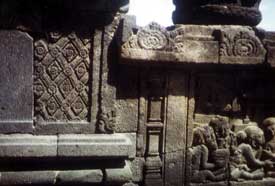
Figure 8 (Click to see larger image) |
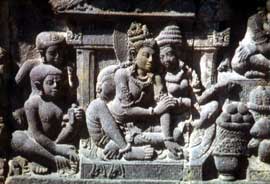
Figure 9 (Click to see larger image) |
Forms
range from very simple to detailed and the stone support is treated
in varying degrees from linear bas-relief to deeply recessed surfaces.
Types of representation include the following: abstract, stylistic
floral patterns and abstract geometric patterns which function as
decorative borders around panels and help to define the architectural
body of the temple (fig. 8); narrative panels which derive from religious
text (fig. 9); icons (fig. 10); naturalistic renderings of animals
and vegetation; and creatures of fantasy, e.g. vegative borders often
metamorphose into demonic masks (fig. 11).
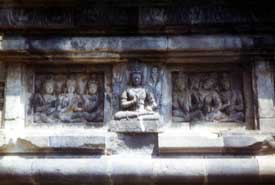
Figure 10 (Click to see larger image) |
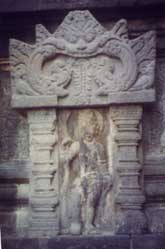
Figure 11 (Click to see larger image) |
Perhaps the multiplicity of types of imagery and their formal treatment
is indicative of the character of Hinduism, where the divine is believed
to have infinite manifestations and multiple approaches to the gods
are not only tolerated but expected. Yet despite its appearance, unity
underlies pluralism. In the following passage, Alain Danielou addresses
Hinduism's diverse expression of a common principle: In the Hindu cosmological
theory symbolism is conceived as the
|
expression
of a reality, as a search for particular points where different
worlds meet and where the relation between entities belonging
to different orders of things may become apparent. According
to the Hindu view, all the aspects of the manifest world spring
from similar principles-- have, we might say, a common ancestry.
There is of necessity some sort of equivalence between sounds,
forms, numbers, colors, ideas, as there is also between the
abstractions of the subtle and tanscendent worlds on one side
and the forms of the perceptible universe on the other. The
Shiva shrine is the largest in the Prambanan group (fig. 12).
The temple is entered by climbing a steep set of stairs on the
east side. A platform, midway up the staircase, encircles the
temple's body. Here, on the inside of the balustrade, are the
Ramayana panels, the most notable reliefs in Hindu-Javanese
art. The imagery on these panels is adapted from a Javanese
version of the Indian epic The Ramayana. In brief, this is the
tale of the god Vishnu's incarnation as Prince Rama. When his
wife Sita is abducted by the demon -giant Ravana, Rama and his
brother-in-law attempt to rescue her. The majority of the story
describes these adventures.
|
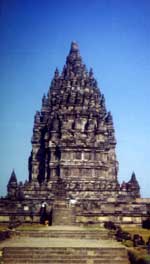
Figure 12 (Click for larger image) |
The narrative
panels are organized in a clockwise fashion begining with Vishnu taking
the form of Rama. Each panel contains at least two scenes, which progress
from left to right. The scale of the figures is made to fit within
the border. The story's main characters are always the most pronounced
in terms of size, regardless of whether they are human or giant. There
are also many naturalistic details, such as birds, monkeys, trees,
etc., that are incorporated into the scenes, around the parameter
and occasionally function to break-up the space so that one scene
can be distinguished from another.
|
There
are a few panels which show a series of time sequences simultaneously
within the same field, and not just two progressive, yet separate,
scenes. The 15th panel is a good example of this (fig. 14).
It illustrates the hero shooting a golden deer with his arrow.
The animal transforms back into his previous state, an evil
giant, and flees. All of this is evident on one frieze: Rama
with arrow, the giant in his magical disguise as deer, and the
giant himself. Since each image appears synchronous, a correct
reading of time progression relies on previous knowledge of
the text and not on the image alone.
|
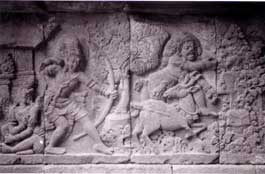
Figure 14 (Click for larger image) |
The
problem of time is inextricable from the question of representation
in works of art which deal with portraying the eternal. Diverse visual
clues must have been developed and utilized to signify the contrast
between timelessness and time. Generally, the eternal world of the
gods is shown as frontal, stylized iconographic forms. The transitory,
relative human world is represented by narrative panels depicting
time sequences (such as Prambanan's Ramayana panels). Although they
represent a different sense of time, these two extreme forms exist
within the same structure as if to illuminate several planes of reality
simultaneously. In the book The Hindu Temple, George Michell writes:
Mythology
juxtaposes relative time sequences and cosmic eras as the keys to
the inner mechanics of the universe. This overlapping of cycles
of time and repetition of cosmic eras finds visual expression in
the forms of the temple, where architectural and sculptural motifs
repeatedly appear in different sizes in different parts of the building.
The finial placed at the summit of the temple symbolizes the absolute
and timeless principle beyond repetition and relativity, and is
intended as a reminder of the ultimate goal of the journey that
man embarks upon.
Hinduism's
spiritual and philosophical tenets helped give a particular form to
its art. As a model of the cosmos, the temple provides a means to
establish a connection with the gods; it opens a pathway toward enlightenment.
The sculptural reliefs were created to aid in this spiritual ideal,
their forms determined in part by this religious conception. The experience
of time, and the idea of timelessness, are also central to the development
of diverse forms of signification as it is necessary to distinguish
one sense of time from the other. I suspect that the notion of unity
underlying diversity permits a general tolerance of plurality in visual
representation in Javanese-Hindu temple sculpture, thus allowing for
various forms to co-exist on the same architectural surface.
BIBLIOGRAPHY
Blurton,
T. Richard. Hindu Art. Massachusetts: Harvard University Press,
1993.
Danielou,
Alain. The Myths and Gods of India. Vermont: Inner Traditions
International, 1964, rpt. 1991.
Dumarcay,
Jacques. Borobudur. England: Oxford University Press, 1979.
Flood,
Gavin. An Introduction to Hinduism. England: Cambridge University
Press, 1996.
Jipto,
Moert and Bambang Prasetyo. The Siwa Temple of Prambanan. Yogyakarta,
Indonesia: Penerbit Kanisius, 1992.
Jipto,
Moert, et al. The Ramayana Reliefs of Prambanan. Yogyakarta,
Indonesia: Penerbit Kanisius, 1991.
Michell,
George. The Hindu Temple: An Introduction to its Meaning and Forms.
Chicago: University of Chicago Press, 1988.
Schapiro,
Meyer. "On Some Problems in the Semiotics of Visual Art: Field and
Vehicle in Image-Signs." Theory and Philosophy of Art: Style, Artist,
and Society: Selected Papers. New York: George Braziller, Inc.,
1994.
Swami
Nikhilananda. Hinduism: Its Meaning for the Liberation of the Spirit.
Madras, India: Sri Ramakrishna Math, 1968.